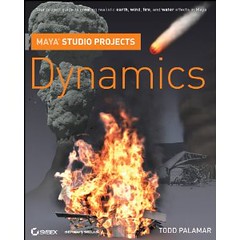Today was a day for research. Or at least that's what I thought before I started.
Continuing on with 'In Silico', I worked through Chapters 12-13. This introduced MEL scripting, and also looked at importing numerical data into Maya. These chapters seemed to ramp up the complexity significantly on previous material, and were difficult to follow. Although I worked through all of the examples, nothing has stuck in my mind and I feel like I haven't gained a huge amount... except the mess of expressions and terms floating around in my mind.
After struggling with the In Silico material, I chose to shift focus to something more creative (and let's say more interesting). Instead of using the Gnomon material to explore the use of dynamics, I have started working on a new book, on loan from the University Library. 'Maya Studio Projects: Dynamics' is written by Todd Palamar and published by Sybex, and deals with creating realistic earth, wind, fire and water effects in Maya. Although my interest lies within creating fire, I decided to look at the particle stuff and see how it compared to using the older Gnomon material.
Within a page of starting, I was already working with simple dynamics setups in Maya. The book was clear, and easy to follow. It made use of high-quality images to complement the textual instructions - something the Gnomon DVDs struggled with.
The first chapter of the Studio Projects book deals with using particles, and has you creating and customising emitters, whilst playing with different types of particles and changing the appearance of the outcome. It uses simple expressions alongside the normal Maya interface. Having completed a couple of examples, I felt better about today's work.
Who knows, after time, the complicated approach of In Silico may make sense. In the meantime I'll walk before I can run, and give this new book a chance.
The first video example shows a comet 'flying' along a path. This was created by applying a lifespan to the particles which 'trailed' from a sphere. Ramp shaders were also applied to colour and transparency values.
The second video example shows an asteroid belt 'orbiting' around a planet (pre-supplied). This was an experiment in using a NURBS circle to emit particles, and then containing them with a cylindrical volume. A ramp was also applied based on the size of the spheres, which was randomised using a simple expression.


No comments:
Post a Comment